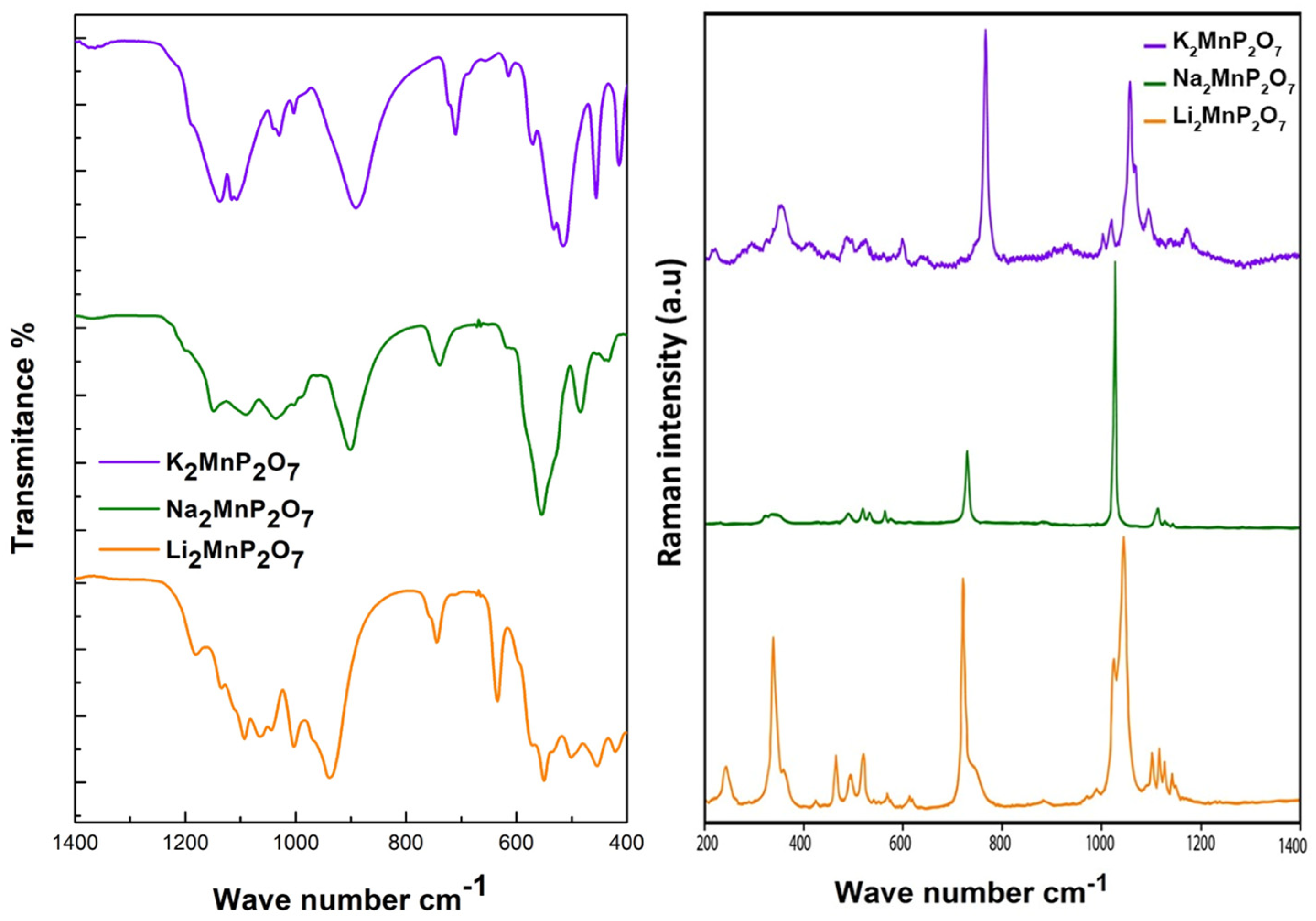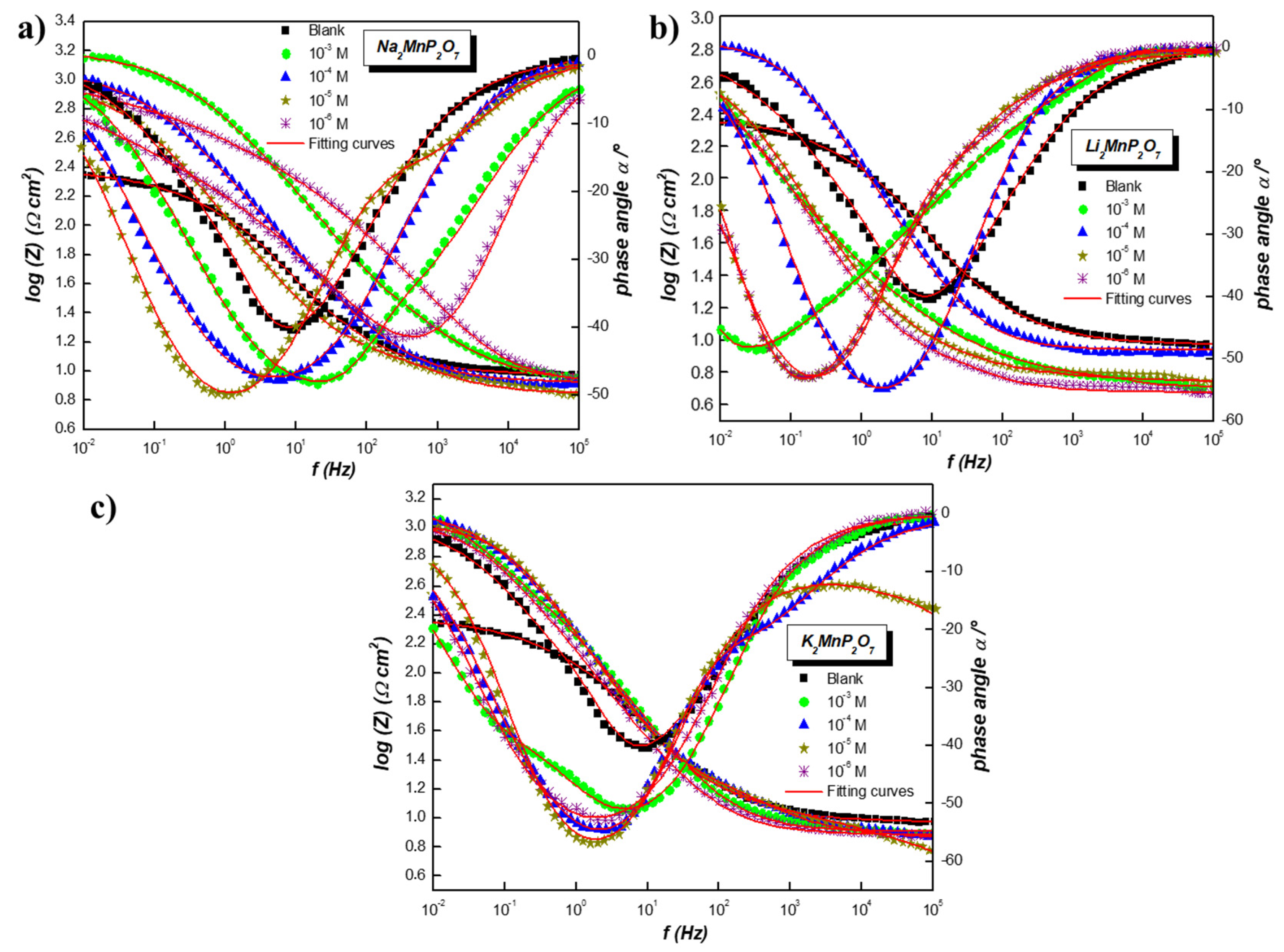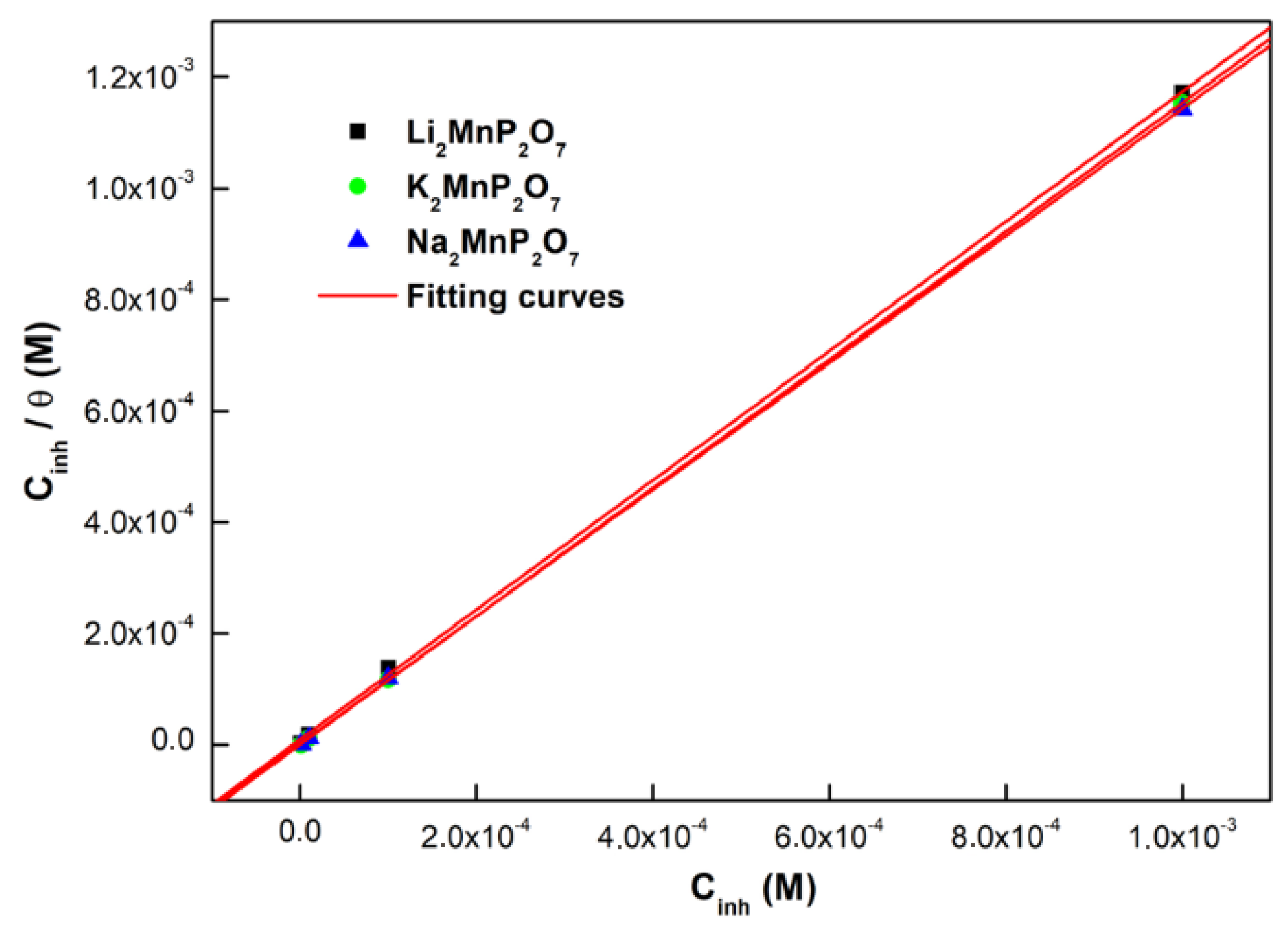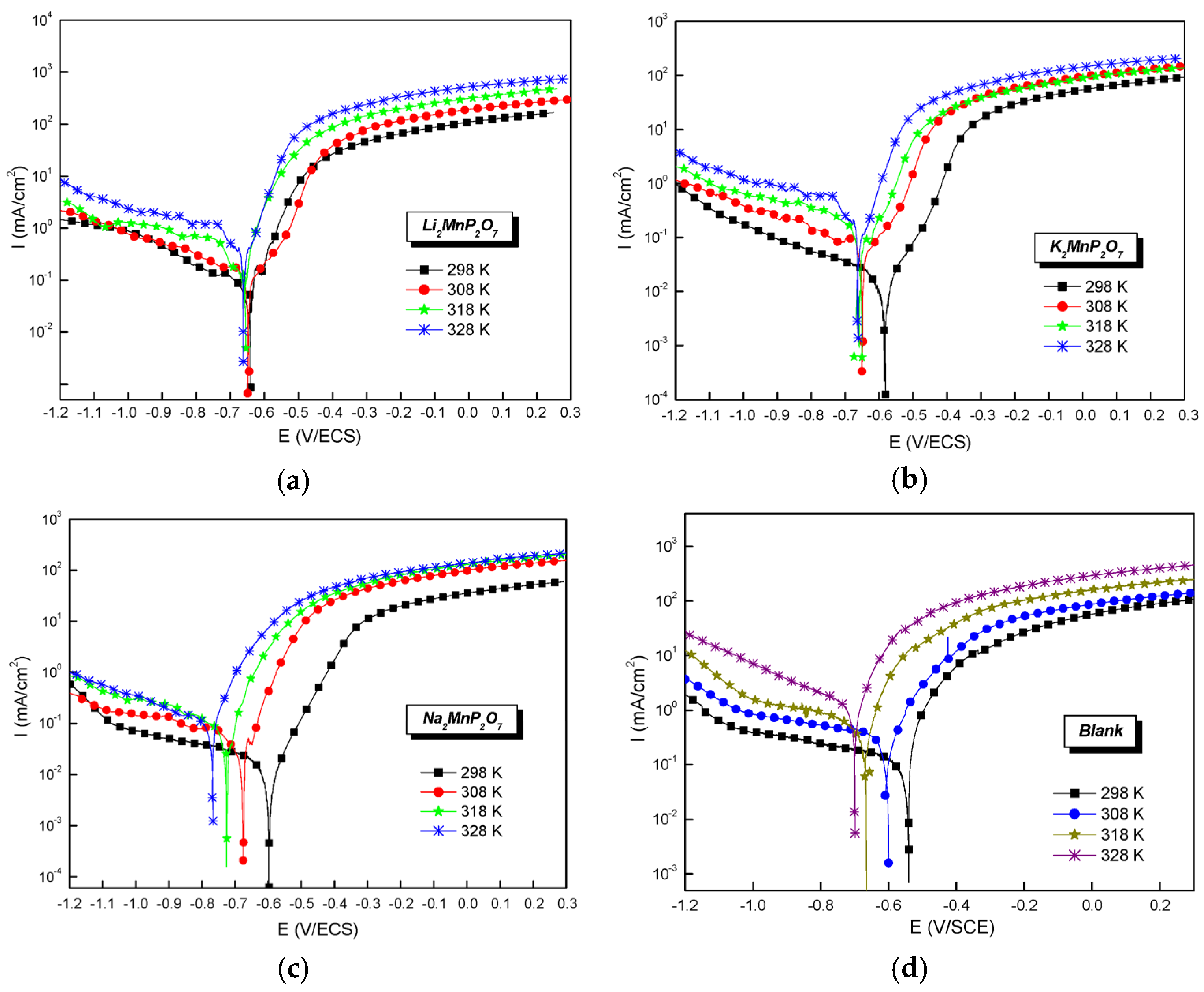Synthesis and Application Insights of New Phosphate Materials A2MnP2O7 (A = Na, K, Li) as Corrosion Inhibitors
Abstract
:1. Introduction
2. Results and Discussion
2.1. X-ray Diffraction
2.2. Spectroscopic Evaluation of A2MnP2O7 (A = Li, Na, K)
2.3. Corrosion Inhibition Studies
2.3.1. Open Circuit Potential (OCP) Measurements
2.3.2. Potentiodynamic Polarization Curves
2.3.3. Electrochemical Impedance Spectroscopy
2.3.4. Analysis of Adsorption Isotherms
2.3.5. Temperature Effect on the Inhibition Behavior
2.3.6. Scanning Electron Microscopy
3. Materials and Methods
3.1. Materials and Sample Preparation
3.2. Synthesis of A2MnP2O7 Compounds
3.3. Characterization
3.4. Electrochemical Measurements
4. Conclusions
Author Contributions
Funding
Data Availability Statement
Conflicts of Interest
References
- Jouini, A.; Gâcon, J.C.; Ferid, M.; Trabelsi-Ayadi, M. Luminescence and Scintillation Properties of Praseodymium Poly and Diphosphates. Opt. Mater. 2003, 24, 175–180. [Google Scholar] [CrossRef]
- Wisniewski, D.; Wojtowicz, A.J.; Drozdowski, W.; Farmer, J.M.; Boatner, L.A. Rb3Lu(PO4)2:Ce and Cs3Lu(PO4)2:Ce—New Promising Scintillator Materials. Cryst. Res. Technol. 2003, 38, 275–282. [Google Scholar] [CrossRef]
- Yuan, J.L.; Wang, J.; Xiong, D.B.; Zhao, J.T.; Fu, Y.B.; Zhang, G.B.; Shi, C.S. Potential PDP Phosphors with Strong Absorption around 172 nm: Rare Earth Doped NaLaP2O7 and NaGdP2O7. J. Lumin. 2007, 126, 717–722. [Google Scholar] [CrossRef]
- Carvajal, J.J.; Parreu, I.; Solé, R.; Solans, X.; Díaz, F.; Aguiló, M. Growth and Structural Characterization of Rb3Yb2(PO4)3: A New Material for Laser and Nonlinear Optical Applications. Chem. Mater. 2005, 17, 6746–6754. [Google Scholar] [CrossRef]
- Vītiņš, Ģ.; Kaņepe, Z.; Vītiņš, A.; Ronis, J.; Dindūne, A.; Lūsis, A. Structural and Conductivity Studies in LiFeP2O7, LiScP2O7, and NaScP2O7. J. Solid State Electrochem. 2000, 4, 146–152. [Google Scholar] [CrossRef]
- Belharouak, I.; Parent, C.; Gravereau, P.; Chaminade, J.P.; Flem, G.L.; Moine, B. Luminescent Properties of Silver(I) Diphosphate of Compositions Na2−xAgxZnP2O7. J. Solid State Chem. 2000, 149, 284–291. [Google Scholar] [CrossRef]
- Hamani, H.; Douadi, T.; Daoud, D.; Al-Noaimi, M.; Rikkouh, R.A.; Chafaa, S. 1-(4-Nitrophenylo-Imino)-1-(Phenylhydrazono)-Propan-2-One as Corrosion Inhibitor for Mild Steel in 1M HCl Solution: Weight Loss, Electrochemical, Thermodynamic and Quantum Chemical Studies. J. Electroanal. Chem. 2017, 801, 425–438. [Google Scholar] [CrossRef]
- Issaadi, S.; Douadi, T.; Zouaoui, A.; Chafaa, S.; Khan, M.A.; Bouet, G. Novel Thiophene Symmetrical Schiff Base Compounds as Corrosion Inhibitor for Mild Steel in Acidic Media. Corros. Sci. 2011, 53, 1484–1488. [Google Scholar] [CrossRef]
- Aloui, S.; Forsal, I.; Sfaira, M.; Touhami, M.E.; Taleb, M.; Baba, M.F.; Daoudi, M. New Mechanism Synthesis of 1,4-Benzothiazine and Its Inhibition Performance on Mild Steel in Hydrochloric Acid. Port. Electrochim. Acta 2009, 27, 599–613. [Google Scholar] [CrossRef]
- Ghailane, T.; Balkhmima, R.A.; Ghailane, R.; Souizi, A.; Touir, R.; Ebn Touhami, M.; Marakchi, K.; Komiha, N. Experimental and Theoretical Studies for Mild Steel Corrosion Inhibition in 1M HCl by Two New Benzothiazine Derivatives. Corros. Sci. 2013, 76, 317–324. [Google Scholar] [CrossRef]
- Panda, A.K.; Purohit, A.K.; Upadhyay, A.; Sahoo, M.K.; Kar, P.K. Corrosion Inhibition Studies on Mild Steel in HCl by a Newly Synthesized Benzil Monohydrazone Based Schiff Base. J. Indian Chem. Soc. 2021, 98, 100245. [Google Scholar] [CrossRef]
- Bayol, E.; Gürten, T.; Gürten, A.A.; Erbil, M. Interactions of Some Schiff Base Compounds with Mild Steel Surface in Hydrochloric Acid Solution. Mater. Chem. Phys. 2008, 112, 624–630. [Google Scholar] [CrossRef]
- Medupin, R.O.; Ukoba, K.O.; Yoro, K.O.; Jen, T.-C. Sustainable Approach for Corrosion Control in Mild Steel Using Plant-Based Inhibitors: A Review. Mater. Today Sustain. 2023, 22, 100373. [Google Scholar] [CrossRef]
- Chami, A.; Benabbou, R.; Taleb, M.; Rais, Z.; El Haji, M. Inhibition of Corrosion of Steel in 1 M HCl Solution by Polyphenol Extract: Application for Steel Used in the Automotive Industry in Morocco. Moroc. J. Chem. 2023, 11, 623–644. [Google Scholar] [CrossRef]
- Salim, A.; Hamham, S.; Ahmed, M.; El Harrari, S.; El mazouzi, S.; Naimi, Y. Study of the Inhibiting Efficiency of the Corrosion Inhibitor (Prop-2-Yn-1-Ol, Methyloxirane) of Mild Steel in the Chemical Pickling (18.5% HCl). Moroc. J. Chem. 2023, 11, 718–728. [Google Scholar] [CrossRef]
- Hamdouch, A.; Anejjar, A.; Bijla, L.; Gharby, S.; Asdadi, A.; Chebli, B.; Salghi, R.; Idrissi Hassani, L.M. Corrosion Inhibition of Carbon Steel by Vitex Agnus Castus Leaves Essential Oils from the Oasis of Tata. Moroc. J. Chem. 2023, 11, 105–118. [Google Scholar] [CrossRef]
- Ebenso, E.; Verma, C.; Olasunkanmi, L.; Akpan, E.; Verma, D.; Lgaz, H.; Guo, L.; Kaya, S.; Quraishi, M. Molecular Modelling of Compounds Used for Corrosion Inhibition Studies: A Review. Phys. Chem. Chem. Phys. 2021, 23, 19987–20027. [Google Scholar] [CrossRef]
- Macedo, R.G.M.d.A.; Marques, N.d.N.; Tonholo, J.; Balaban, R.d.C. Water-Soluble Carboxymethylchitosan Used as Corrosion Inhibitor for Carbon Steel in Saline Medium. Carbohydr. Polym. 2019, 205, 371–376. [Google Scholar] [CrossRef]
- Nardeli, J.V.; Fugivara, C.S.; Taryba, M.; Pinto, E.R.P.; Montemor, M.F.; Benedetti, A.V. Tannin: A Natural Corrosion Inhibitor for Aluminum Alloys. Prog. Org. Coat. 2019, 135, 368–381. [Google Scholar] [CrossRef]
- Dehghani, A.; Bahlakeh, G.; Ramezanzadeh, B.; Ramezanzadeh, M. Potential of Borage Flower Aqueous Extract as an Environmentally Sustainable Corrosion Inhibitor for Acid Corrosion of Mild Steel: Electrochemical and Theoretical Studies. J. Mol. Liq. 2019, 277, 895–911. [Google Scholar] [CrossRef]
- Haleem, S.M.A.E.; Wanees, S.A.E.; Aal, E.E.A.E.; Diab, A. Environmental Factors Affecting the Corrosion Behavior of Reinforcing Steel. IV. Variation in the Pitting Corrosion Current in Relation to the Concentration of the Aggressive and the Inhibitive Anions. Corros. Sci. 2010, 52, 1675–1683. [Google Scholar] [CrossRef]
- Jamil, H.E.; Shriri, A.; Boulif, R.; Bastos, C.; Montemor, M.F.; Ferreira, M.G.S. Electrochemical Behaviour of Amino Alcohol-Based Inhibitors Used to Control Corrosion of Reinforcing Steel. Electrochim. Acta 2004, 49, 2753–2760. [Google Scholar] [CrossRef]
- Nahali, H.; Dhouibi, L.; Idrissi, H. Effect of Phosphate Based Inhibitor on the Threshold Chloride to Initiate Steel Corrosion in Saturated Hydroxide Solution. Constr. Build. Mater. 2014, 50, 87–94. [Google Scholar] [CrossRef]
- Bastidas, D.M.; Martin, U.; Bastidas, J.M.; Ress, J. Corrosion Inhibition Mechanism of Steel Reinforcements in Mortar Using Soluble Phosphates: A Critical Review. Materials 2021, 14, 6168. [Google Scholar] [CrossRef] [PubMed]
- Elhafiane, F.Z.; Khaoulaf, R.; Harcharras, M.; Brouzi, K. Synthesis, Crystal Structure, Vibrational Spectroscopy and Electrochemical Investigations of a New Acidic Metal Pyrophosphate NiK1.18N0.82(H2P2O7)2.2H2O. J. Mol. Struct. 2021, 1245, 131234. [Google Scholar] [CrossRef]
- Khmiyas, J.; Kerroum, Y.; Aoufir, Y.E.; Guenbour, A.; Bellaouchou, A.; Zarrouk, A.; Assani, A.; Saadi, M.; Ammari, L.E. Synthesis of Novel Orthophosphate Compound AgSr4Cu4.5(PO4)6: Characterization and Anticorrosion Activities. Chem. Data Collect. 2022, 41, 100912. [Google Scholar] [CrossRef]
- Hasumi, M.; Taniguchi, I. Synthesis and Characterization of Li2MnP2O7/C Composite by a Combination of Spray Pyrolsis and Wet Ball Milling Followed by Annealing. Mater. Lett. 2014, 134, 202–205. [Google Scholar] [CrossRef]
- Kaoua, S.; Krimi, S.; Péchev, S.; Gravereau, P.; Chaminade, J.-P.; Couzi, M.; Jazouli, A.E. Synthesis, Crystal Structure, and Vibrational Spectroscopic and UV–Visible Studies of Cs2MnP2O7. J. Solid State Chem. 2013, 198, 379–385. [Google Scholar] [CrossRef]
- Ye, Y.; Zou, Y.; Jiang, Z.; Yang, Q.; Chen, L.; Guo, S.; Chen, H. An Effective Corrosion Inhibitor of N Doped Carbon Dots for Q235 Steel in 1 M HCl Solution. J. Alloys Compd. 2020, 815, 152338. [Google Scholar] [CrossRef]
- Hirschorn, B.; Orazem, M.E.; Tribollet, B.; Vivier, V.; Frateur, I.; Musiani, M. Determination of Effective Capacitance and Film Thickness from Constant-Phase-Element Parameters. Electrochim. Acta 2010, 55, 6218–6227. [Google Scholar] [CrossRef]
- Bouammali, H.; Jama, C.; Bekkouch, K.; Aouniti, A.; Hammouti, B.; Bentiss, F. Anticorrosion Potential of Diethylenetriaminepentakis (Methylphosphonic) Acid on Carbon Steel in Hydrochloric Acid Solution. J. Ind. Eng. Chem. 2015, 26, 270–276. [Google Scholar] [CrossRef]
- Shahryari, Z.; Gheisari, K.; Yeganeh, M.; Ramezanzadeh, B. Corrosion Mitigation Ability of Differently Synthesized Polypyrrole (PPy-FeCl3 & PPy-APS) Conductive Polymers Modified with Na2MoO4 on Mild Steel in 3.5% NaCl Solution: Comparative Study and Optimization. Corros. Sci. 2021, 193, 109894. [Google Scholar] [CrossRef]
- Abdel-Gaber, A.M.; Abd-El-Nabey, B.A.; Sidahmed, I.M.; El-Zayady, A.M.; Saadawy, M. Inhibitive Action of Some Plant Extracts on the Corrosion of Steel in Acidic Media. Corros. Sci. 2006, 48, 2765–2779. [Google Scholar] [CrossRef]
- Flis, J.; Zakroczymski, T. Impedance Study of Reinforcing Steel in Simulated Pore Solution with Tannin. J. Electrochem. Soc. 1996, 143, 2458–2464. [Google Scholar] [CrossRef]
- Wang, D.-Y.; Nie, B.-L.; Li, H.-J.; Zhang, W.-W.; Wu, Y.-C. Anticorrosion Performance of Grape Seed Proanthocyanidins Extract and Tween-80 for Mild Steel in Hydrochloric Acid Medium. J. Mol. Liq. 2021, 331, 115799. [Google Scholar] [CrossRef]
- Fouda, A.S.; Ismail, M.A.; Abou-shahba, R.M.; Husien, W.A.; EL-Habab, E.S.; Abousalem, A.S. Experimental and Computational Chemical Studies on the Cationic Furanylnicotinamidines as Novel Corrosion Inhibitors in Aqueous Solutions. Chin. J. Chem. Eng. 2020, 28, 477–491. [Google Scholar] [CrossRef]
- Alharthi, N.H.; El-Hashemy, M.A.; Derafa, W.M.; Althobaiti, I.O.; Altaleb, H.A. Corrosion Inhibition of Mild Steel by Highly Stable Polydentate Schiff Base Derived from 1,3-Propanediamine in Aqueous Acidic Solution. J. Saudi Chem. Soc. 2022, 26, 101501. [Google Scholar] [CrossRef]
- Al-Amiery, A.A.; Shaker, L.M.; Kadhum, A.H.; Takriff, M.S. Exploration of Furan Derivative for Application as Corrosion Inhibitor for Mild Steel in Hydrochloric Acid Solution: Effect of Immersion Time and Temperature on Efficiency. Mater. Today Proc. 2021, 42, 2968–2973. [Google Scholar] [CrossRef]
- Fouda, A.S.; Ellithy, A.S. Inhibition Effect of 4-Phenylthiazole Derivatives on Corrosion of 304L Stainless Steel in HCl Solution. Corros. Sci. 2009, 51, 868–875. [Google Scholar] [CrossRef]










| K2MnP2O7 | Na2MnP2O7 | Li2MnP2O7 | Attribution | |||
|---|---|---|---|---|---|---|
| IR (cm−1) | Ra (cm−1) | IR (cm−1) | Ra (cm−1) | IR (cm−1) | Ra (cm−1) | |
| 1137 | 1175 | 1148 | 1152 | 1183 | 1182 | ƲasPO3 ƲsPO3 |
| 1108 | 1150 | 1087 | 1141 | 1135 | 1163 | |
| 1028 | 1120 | 1038 | 1130 | 1094 | 1104 | |
| 1001 | 1112 | 1027 | 1063 | 1084 | ||
| 1105 | 1041 | 1035 | ||||
| 1024 | 1000 | 1021 | ||||
| 1013 | ||||||
| 983 | ||||||
| 888 | 891 | 905 | 902 | 937 | 942 | ƲasPOP |
| 710 | 740 | 743 | 732 | 745 | 787 | ƲsPOP |
| 612 | 603 | 618 | 592 | 635 | 632 | δPO3 |
| 568 | 582 | 555 | 583 | 572 | 604 | |
| 535 | 506 | 484 | 543 | 550 | 591 | |
| 515 | 493 | 432 | 522 | 502 | 531 | |
| 460 | 460 | 490 | 454 | 524 | ||
| 455 | 409 | 335 | 420 | 516 | ||
| 414 | 370 | 249 | 483 | |||
| 260 | 424 | |||||
| 411 | ||||||
| 354 | ||||||
| 332 | ||||||
| 302 | ||||||
| 221 | ||||||
| Compounds | C (M) | −Ecorr mV/ECS | icorr µA cm−2 | |
|---|---|---|---|---|
| Blank | - | 559 | 464 | - |
| Li2MnP2O7 | 10−3 | 641 | 62 | 86.6 |
| 10−4 | 653 | 126 | 72.8 | |
| 10−5 | 657 | 212 | 54.3 | |
| 10−6 | 614 | 265 | 42.9 | |
| K2MnP2O7 | 10−3 | 580 | 60 | 87.0 |
| 10−4 | 551 | 65 | 85.9 | |
| 10−5 | 553 | 78 | 83.2 | |
| 10−6 | 597 | 84 | 81.9 | |
| Na2MnP2O7 | 10−3 | 597 | 54 | 88.3 |
| 10−4 | 594 | 76 | 83.6 | |
| 10−5 | 577 | 90 | 80.6 | |
| 10−6 | 557 | 103 | 77.8 |
| C (M) | Rs (Ω cm2) | Rf (Ω cm2) | nf | Qf (µF/cm2) | Ceff,f (µF/cm2) | Rct (Ω cm2) | nct | Qct (µF/cm2) | Ceff,dl (µF/cm2) | Rp (Ω cm2) | η% |
|---|---|---|---|---|---|---|---|---|---|---|---|
| 3 wt.% NaCl | 10.2 | 161.0 | 0.705 | 1399 | 750 | 38.0 | 0.99 | 1451 | 1387 | 199.0 | - |
| Li2MnP2O7 | |||||||||||
| 10−3 | 5.8 | 260 | 0.603 | 1618 | 915 | 1091 | 0.731 | 678 | 88.15 | 1351 | 85.3 |
| 10−4 | 8.6 | 148 | 0.728 | 1297 | 700 | 562 | 0.729 | 935 | 154.76 | 710 | 72.0 |
| 10−5 | 6.5 | 51 | 0.811 | 1704 | 964 | 376 | 0.813 | 1047 | 330.95 | 427 | 53.4 |
| 10−6 | 5.4 | 32 | 0.812 | 1845 | 958 | 314 | 0.805 | 1124 | 325.06 | 346 | 42.5 |
| K2MnP2O7 | |||||||||||
| 10−3 | 8.0 | 637 | 0.683 | 341 | 168 | 866 | 0.786 | 283 | 53.76 | 1503 | 86.7 |
| 10−4 | 6.7 | 229 | 0.675 | 1121 | 582 | 1150 | 0.901 | 196 | 94.48 | 1379 | 85.5 |
| 10−5 | 8.5 | 137 | 0.714 | 1129 | 535 | 1003 | 0.992 | 219 | 208.16 | 1140 | 82.5 |
| 10−6 | 7.6 | 250 | 0.667 | 1024 | 519 | 827 | 0.652 | 359 | 15.29 | 1077 | 81.5 |
| Na2MnP2O7 | |||||||||||
| 10−3 | 3.4 | 1261 | 0.641 | 397 | 269 | 335 | 0.890 | 641 | 300.15 | 1596 | 87.5 |
| 10−4 | 8.8 | 886 | 0.609 | 499 | 295 | 284 | 0.923 | 759 | 498.50 | 1170 | 83.0 |
| 10−5 | 7.8 | 615 | 0.694 | 684 | 467 | 380 | 0.954 | 586 | 451.48 | 995 | 80.0 |
| 10−6 | 1.2 | 440 | 0.641 | 837 | 478 | 428 | 0.686 | 473 | 15.43 | 868 | 77.0 |
| Medium (3 wt. % NaCl) | Kads (L/mol) | ΔGads (Kj/mol) | R2 | Slopes |
|---|---|---|---|---|
| Li2MnP2O7 | 101.5 103 | −38.5 | 0.999 | 1.16 |
| K2MnP2O7 | 315.1 104 | −47.0 | 1 | 1.15 |
| Na2MnP2O7 | 412.8 103 | −42.0 | 0.9999 | 1.14 |
| Compounds | Temp. (K) | −Ecorr (mV/SCE) | (µA cm−2) | η % |
|---|---|---|---|---|
| 3 wt.% NaCl | 298 | 559 | 464 | - |
| 308 | 594 | 758 | - | |
| 318 | 664 | 1353 | - | |
| 328 | 696 | 2170 | - | |
| Li2MnP2O7 | 298 | 641 | 62 | 86.6 |
| 308 | 613 | 117 | 84.5 | |
| 318 | 653 | 246 | 81.8 | |
| 328 | 660 | 468 | 78.4 | |
| K2MnP2O7 | 298 | 580 | 60 | 87.0 |
| 308 | 644 | 118 | 84.4 | |
| 318 | 651 | 245 | 81.8 | |
| 328 | 659 | 472 | 78.2 | |
| Na2MnP2O7 | 298 | 597 | 54 | 88.3 |
| 308 | 672 | 105 | 86.1 | |
| 318 | 733 | 223 | 83.5 | |
| 328 | 758 | 412 | 81.0 |
Disclaimer/Publisher’s Note: The statements, opinions and data contained in all publications are solely those of the individual author(s) and contributor(s) and not of MDPI and/or the editor(s). MDPI and/or the editor(s) disclaim responsibility for any injury to people or property resulting from any ideas, methods, instructions or products referred to in the content. |
© 2024 by the authors. Licensee MDPI, Basel, Switzerland. This article is an open access article distributed under the terms and conditions of the Creative Commons Attribution (CC BY) license (https://creativecommons.org/licenses/by/4.0/).
Share and Cite
Moumouche, O.; El Harmouchi, H.; Alami, S.; Ouakki, M.; Khaoulaf, R.; Brouzi, K.; Ebn Touhami, M.; Lgaz, H.; Harcharras, M. Synthesis and Application Insights of New Phosphate Materials A2MnP2O7 (A = Na, K, Li) as Corrosion Inhibitors. Inorganics 2024, 12, 116. https://doi.org/10.3390/inorganics12040116
Moumouche O, El Harmouchi H, Alami S, Ouakki M, Khaoulaf R, Brouzi K, Ebn Touhami M, Lgaz H, Harcharras M. Synthesis and Application Insights of New Phosphate Materials A2MnP2O7 (A = Na, K, Li) as Corrosion Inhibitors. Inorganics. 2024; 12(4):116. https://doi.org/10.3390/inorganics12040116
Chicago/Turabian StyleMoumouche, Oumaima, Hammadi El Harmouchi, Safae Alami, Moussa Ouakki, Redouane Khaoulaf, Khalid Brouzi, Mohamed Ebn Touhami, Hassane Lgaz, and Mohamed Harcharras. 2024. "Synthesis and Application Insights of New Phosphate Materials A2MnP2O7 (A = Na, K, Li) as Corrosion Inhibitors" Inorganics 12, no. 4: 116. https://doi.org/10.3390/inorganics12040116







